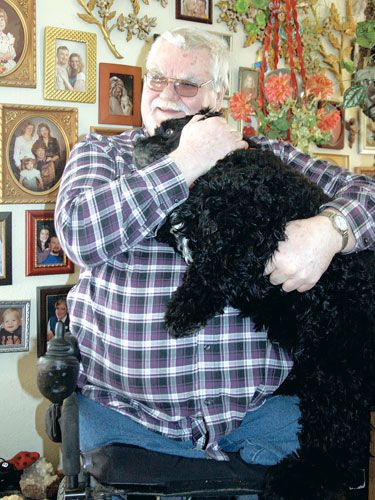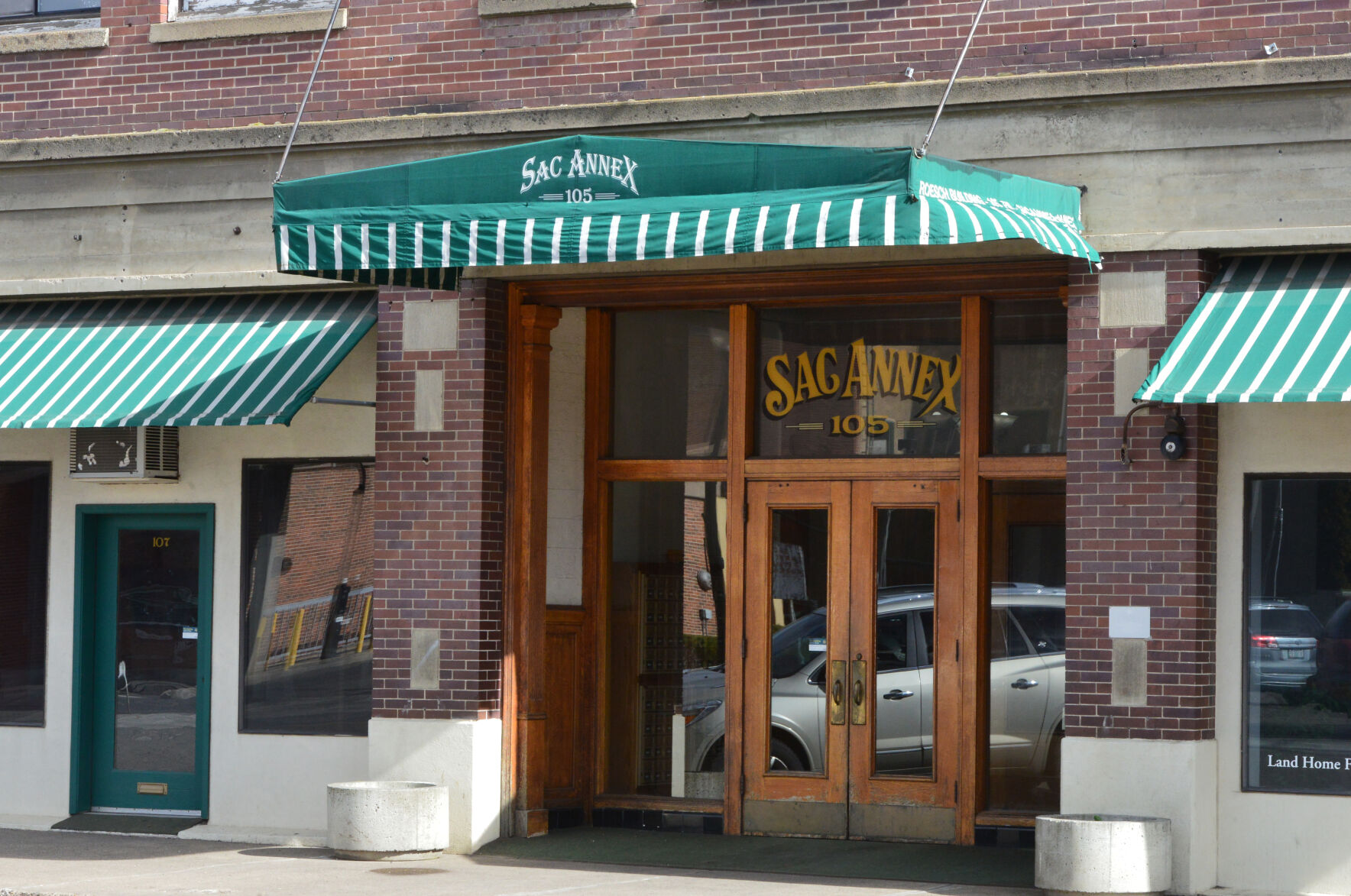The will to live
Published 1:07 pm Monday, May 13, 2013

- La Grande High School graduate Ron Gillis plays with his dog, Casey, at Gillis mothers home in La Grande. Gillis was involved in an accident with a log chipper at a small mill in Long Creek. The accident took Gillis legs. (Chris Baxter/The Observer)
La Grande graduate Ron Gillis has always had a fighting spirit. In 1975, that fighting spirit was put to the ultimate test when an accident at a mill took his legs.
Ron Gillis has always been a fighter. He braved long hair and the ire of rednecks during high school in La Grande during the 1960s.
“I did a lot of fighting in my younger days,” Gillis said.
On May 16, 1975, that same fighting spirit saved his life.
Gillis was working at a small mill in Long Creek on a log chipper machine, which chewed timber into one-inch chips. At 23 years old, Gillis was a muscular, 6-foot-3, 220-pound man, and, frankly, bored by the chipper machine.
“Watching the chipper was not a job I wanted. I told my boss I was going to quit unless he took me off that stupid chipper,” Gillis said.
The boss promised to move him but told Gillis to finish out the day. Those turned out to be costly orders.
Two hours before closing, the chip conveyor belt stopped. Gillis thought the chipper might be jammed. So he shut down the power to the chip belt and also the main conveyor belt, but the chipper itself kept running. He climbed up into the feed trough on the main conveyor belt. After checking the machine, Gillis pushed what he thought was the button for the chip conveyor.
Gillis had been misinformed.
The belt where he stood lurched forward, throwing Gillis down on his back and carrying him toward the whirling 14-inch blades. Instantly, Gillis grabbed at the side guard for a handhold and braced his legs up in a “V.”
The blades were mere inches from the seat of his pants. Gillis could feel the wind from the blades on the back of his legs. As Gillis struggled against theconveyor belt, he worried that a mill worker would drop timber onto the conveyor belt into the feeder trough and knock him through.
Gillis might have been able to pull himself away from the blades, but the spiked feed roller, designed to move logs into the blades, kept catching his leather belt. Gillis struggled to reposition himself away from the feed roller.
“I tried to get a toe-hold,” he said.
He felt no pain but suddenly his face was covered in blood, bone and tissue. Hoisting himself by his arms, Gillis blindly pulled himself off the moving belt and onto the side of the dreadful machine.
He wiped at his eyes. He looked down. He had no legs.
There was blood everywhere. Above where his kneecaps had been, blood was squirting from the major arteries in his thighs.
Gillis had the presence of mind to reach down and hold both arteries to stop the blood. That action probably saved his life.
Minutes passed as he waited for someone from the mill to find him, for someone to call the ambulance for help and for someone to tourniquet his legs.
Gillis never blacked out. He even remembers hearing a mill worker whisper, “There’s no way he’s gonna make it.”
Gillis retorted, “I’m going to make it. You think I got out of the damn chipper just to die?”
The ambulance in Long Creek was a 1940s- or ’50s-vintage vehicle. When the call came in about the double amputation at the wood chipper, it would not start.
Dr. William Stahl was a trauma doctor working about 40 miles away at the hospital in John Day. Stahl had worked as a medic in Vietnam. He had experience with loss of limbs due to land mines. When he learned that the ambulance would not start, he jumped into his Corvette and drove toward Long Creek. He met the ambulance halfway and climbed in to assess Gillis’ injury.
Later, Stahl told Gillis, “I’d never seen anything like it, even in
Vietnam.”
Gillis remembers meeting Stahl and immediately fighting over ice cubes and pain medicine. Gillis was incredibly thirsty and trying to eat the ice that was packed around his legs. Stahl told Gillis that until he got blood transfusions, water and pain medicine would kill him. Stahl kept taking the ice out of Gillis’ hands, and Gillis kept grabbing for more.
Finally Stahl said, “There ain’t nothing going to kill you anyway.”
Gillis ate the ice.
Stahl was firm on the pain medicine. Gillis needed four or five pints of blood first.
At the hospital, Gillis watched the pints of blood feed into his bloodstream. The pain was rising to intolerable levels.
“Seeing the fourth one go in,” Gillis said, “I wanted pain medicine now.”
Stahl had stepped out of the emergency room. The nurse in charge refused Gillis’ request.
Enraged by pain, somehow Gillis sat up on the table and took a swing at the nurse. The nurse ducked. Gillis toppled forward off the table and landed on his back.
Gillis remembers that Stahl was furious at the nurse for not taking the swing. Fifteen years later, Gillis happened to cross paths with the nurse at the entrance of Grand Ronde Hospital.
The nurse pleadingly joked, “Don’t hit me.”
After seven pints of blood and surgery to close his stumps, Gillis stayed for three days at the hospital under Stahl’s care before being transferred home to La Grande.
Gillis spent about 15 days at the Grand Ronde Hospital. He fired his first doctor for not giving him enough pain medicine. His second doctor scolded the staff for treating Gillis’ trauma like a toothache.
Gillis tried morphine but that only lasted a week. The morphine-induced nightmares were horrible.
“Every way you could lose your legs, I dreamed it: sharks, crocodiles, blown up,” Gillis said. “Then I would wake up totally covered in sweat.”
Gillis wanted to go home.
He told his family doctor, Treve Lumsden, “If you don’t let me out of here, I will hijack a wheelchair and head home anyway.”
Lumsden replied, “If you can get by on Tylenol 3, you can go home.”
Gillis went home at least three to four weeks early.
His parents, Norma and Gene Gillis, set up a hospital bed in the family den. Gillis and his dad changed his bandages. His mom changed out the bed sheets three to four times a night when Gillis woke up soaked with sweat due to pain.
“I’m still mad at those doctors for not giving him more pain medicine,” Norma Gillis said.
Four or five months later, Gillis spent time at a rehabilitation institute in Portland. Because Gillis was so strong, he progressed quickly at rehab but he never liked prosthetic legs.
“Three times I tried legs and three times I hated them,” he said.
Gillis could go anywhere he wanted in a wheelchair or by using his arms. If his buddies were down fishing by the river, he could climb down the bank. If his younger cousins tried to escape during play, he could beat them up the stairs. He even swam across the Snake River near Richland.
Gillis remembers sitting on the hood of his 1974 Dodge pickup that had a high-rise manifold and fancy burnt orange paint. He could just jump off and land on his hands.
But pain has been a constant companion for Gillis. At the age of 27, he was arrested, fined $1,500 and sentenced to four years probation for the possession of 19-1/2 ounces of marijuana. Gillis testified at a pre-sentence hearing that he used the marijuana for pain relief.
These days Gillis takes several medications and uses medical marijuana to manage his pain.
“I smoke a little every day,” said Gillis.
The regimen, along with consistent chiropractic care, seems to be working. Gillis’ pain levels have mostly stabilized at a more manageable level although periodically he still suffers from horrible nerve pain.
When Gillis reflects back on the accident nearly 38 years ago, he concludes, “My temper kept me alive. It was a good thing then.”
Gillis was featured in the July 1976 bicentennial edition of Reader’s Digest in a Drama in Real Life story called “Two Seconds to Live.” The moment-by-moment replay of Gillis’ horrifying accident was such a dramatic read that a few years ago someone from Reader’s Digest told Gillis it remains one of the most popular Drama in Real Life stories.
These days Gillis reflects on other significant events of his life: his marriage to Laurel Reagan, their four daughters and seven grandkids, times hunting with his dad and fishing with his grandkids.
“I’ve had a pretty good life,” Gillis said.
Some would say Gillis’ life has not been easy. The injury and resulting pain impacted his career choices. His wife has had two brain surgeries due to brain aneurisms. They both face chronic pain.
But Gillis is optimistic.
“I did alright,” he said. “I found a way to do what I wanted to do.”
“He always stayed positive,” said Norma Gillis. “Nothing stops him.”
Six or seven years ago, Gillis tracked down Stahl who was working in a trauma unit in Clackamas. They laughed about fighting over ice and Gillis taking a swing at the nurse.
Stahl recalled Gillis’ will to live and told Gillis, “I’ve never seen anyone fight like you.”





